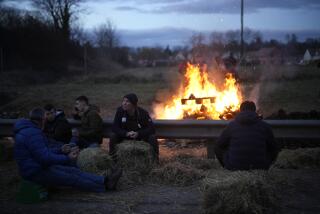New Lease on Soviet Farm Life?
- Share via
Sixty years ago Josef Stalin set out to make agriculture one of the Soviet Union’s great triumphs. What he achieved instead was one of communism’s abiding failures. Stalin’s strongly resisted effort to collectivize the peasantry and turn it into a rural proletariat led to millions of deaths from starvation and forced labor and created a system of staggering waste and inefficiency. Official efforts to idealize collectivization also gave rise to some of the worst art of the 20th Century. For decades, Soviet leaders have refused to face the truth that an agricultural policy based on ideology has left their country unable to feed itself. Mikhail S. Gorbachev has broken with that tradition. With the support of the Communist Party’s Central Committee, he is now prepared to allow a large measure of private enterprise in Soviet agriculture. It is an idea born of compelling economic necessity and growing public anger. Even with that formidable parentage, however, there are strong doubts it can work.
The necessity for change derives from chronic food shortages, the result of both low productivity and of a system of storage and distribution so appallingly wasteful that at least one-third of all food produced rots before it reaches consumers. Incentives to do better at the production level disappeared two generations ago when peasants were herded on to state or collective farms. In both cases, farmers in effect became hired employees and agriculture became rigidly administered. Today the Soviet Union counts 4 million non-producing bureaucrats among its approximately 14 million farm workers. That’s more agricultural bureaucrats than the United States has farmers.
In broad outline Gorbachev’s plan is to let farmers lease land from the state for life and even pass it on as an inheritance to their children. He hopes that by providing for such quasi-ownership of property, farmers would be encouraged to work harder, grow more food and profit from their labors. Then, assuming the state is able to cut food losses by investing more in paved roads, railways and refrigerated warehouses, the public could look forward to a more plentiful and varied diet, long waiting lines at food stores would disappear, people would be more content and perestroika would take a big leap forward.
That at least is the theory. Two immense barriers stand in the way of making it reality. One is the opposition of party conservatives who think Gorbachev is going too far in bending or walking away from the ideology they have been raised on; Yegor Ligachev, bumped by Gorbachev last year as chief party ideologist and now minister of agriculture, is among those. So presumably are the 4 million farm bureaucrats who could find themselves needing new jobs if privatization replaces collectivization on a big scale.
The second barrier is the farm population itself. Tatyana Zaslavskaya, a Soviet sociologist, has raised what for Gorbachev must be the chilling possibility that decades of state-managed agriculture have effectively done away with the age-old tradition that connected farmers to the soil and made them, as Gorbachev has said, “masters of the land.” For two generations, farmers have been without incentives to produce more; as hired hands they were taken care of whether they were slothful or energetic, efficient or incompetent. Will farmers now want to abandon the security of collectivization for the hard work and risks of private enterprise? Will they even be given the chance to do so by the ideologists and farm bureaucrats? Gorbachev, after a long internal struggle, has won endorsement for his new agricultural policy. Now he faces the infinitely harder task of trying to make it work.
More to Read
Sign up for Essential California
The most important California stories and recommendations in your inbox every morning.
You may occasionally receive promotional content from the Los Angeles Times.













